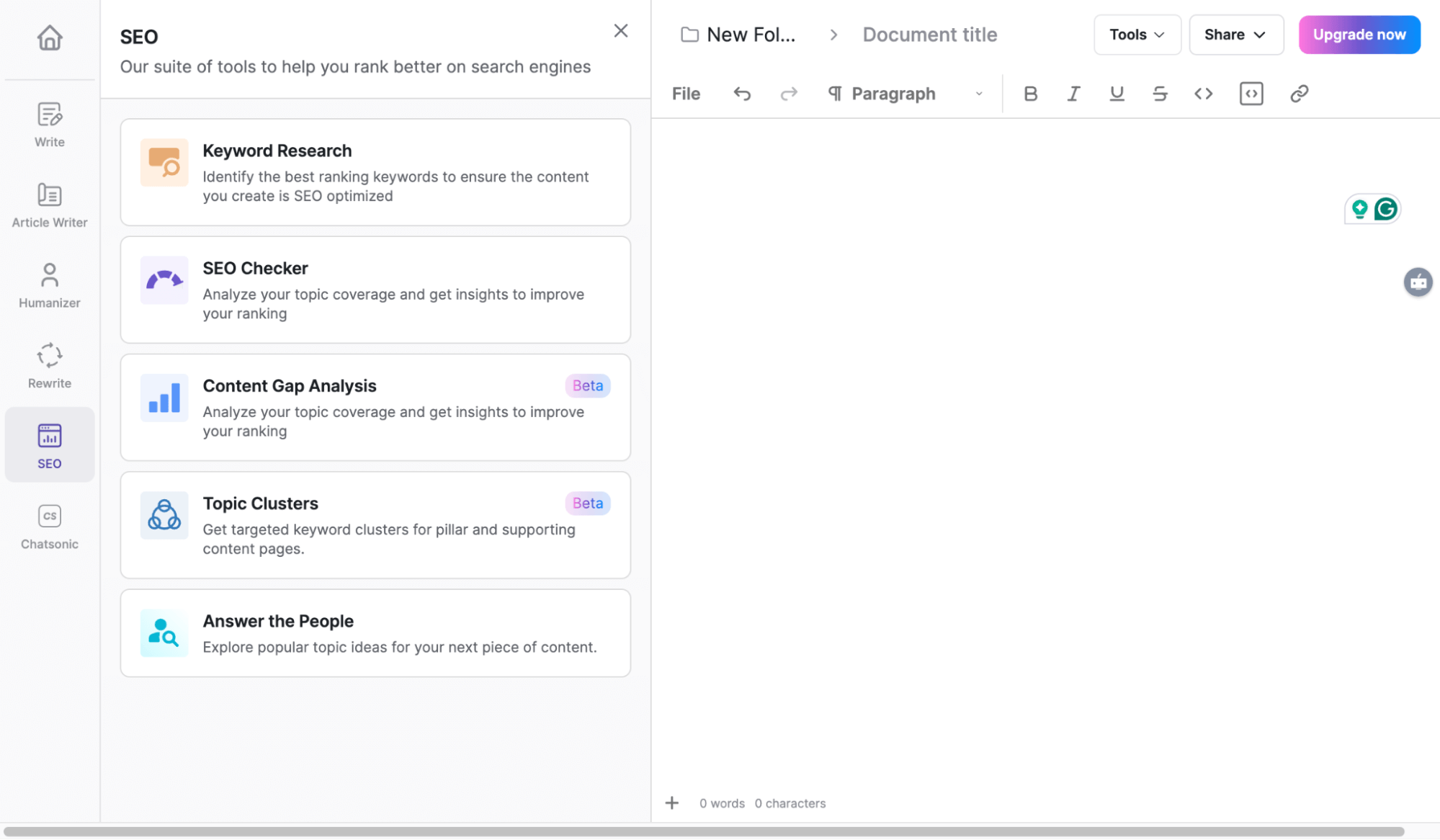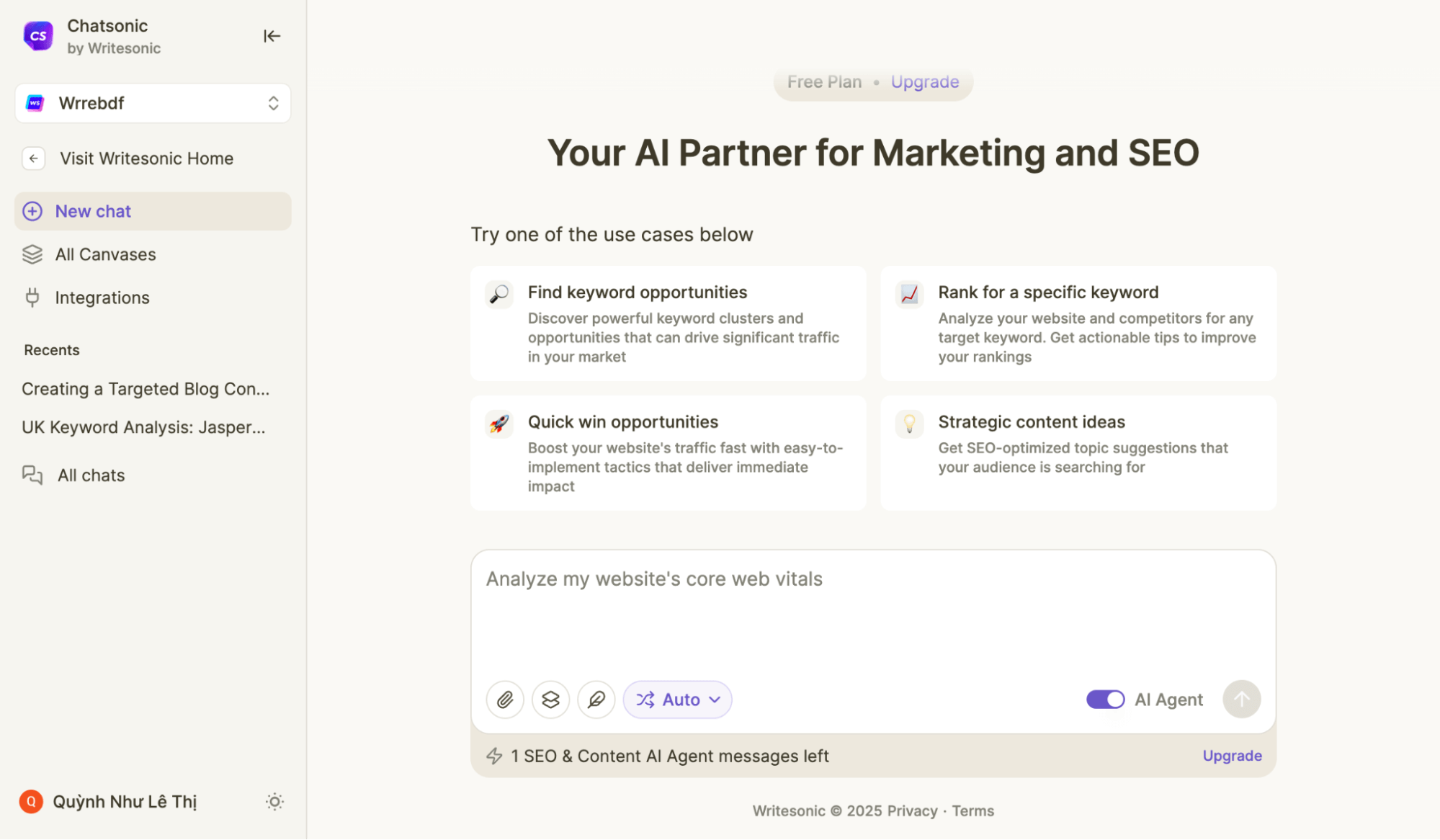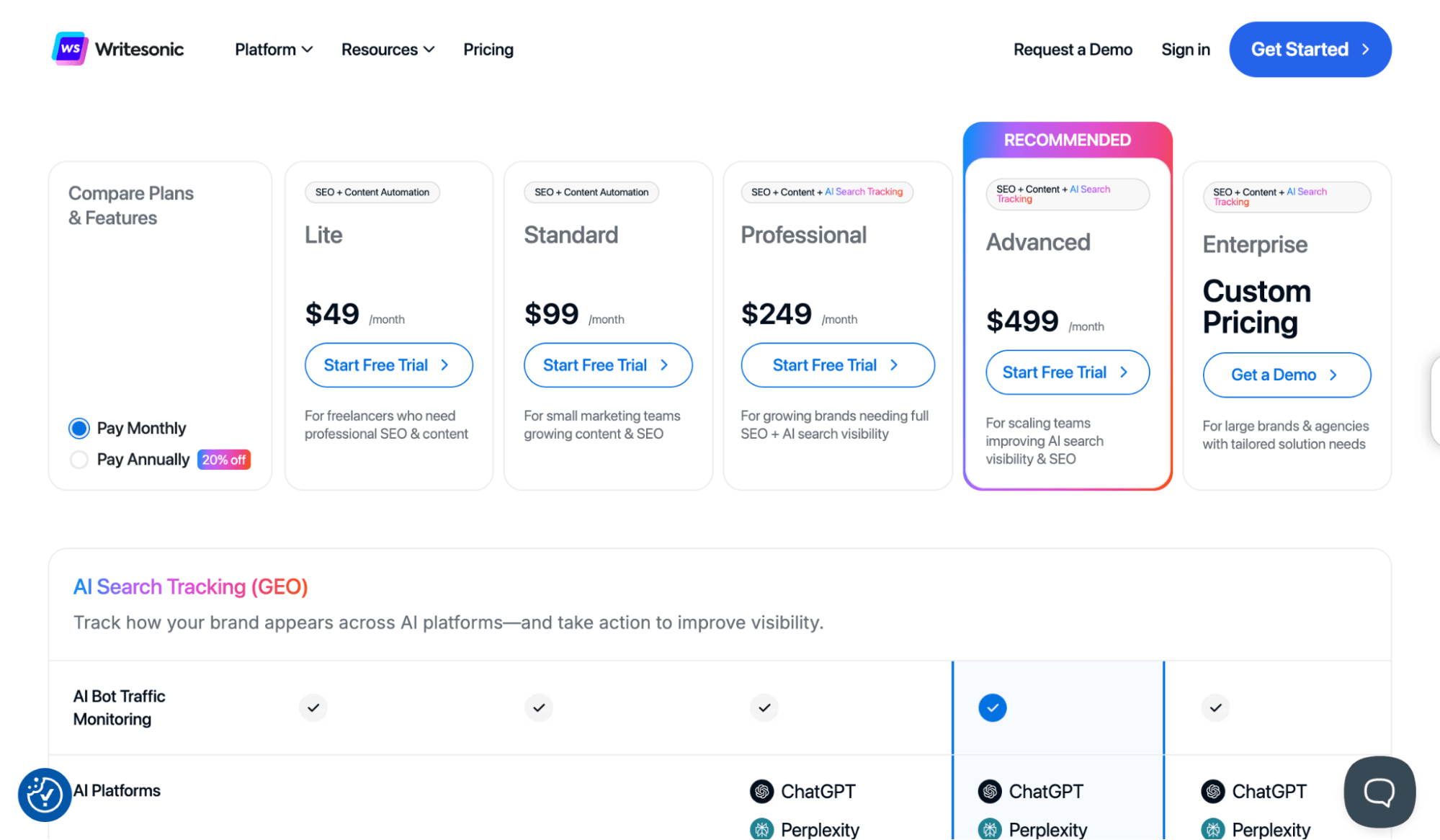
You open a blank doc to draft a product page due tomorrow. Ten tabs later, you’re still juggling outlines, SEO notes, and a half-written intro that sounds… meh. That’s usually when people search Google for AI writing tools. But the real question is: “Which one should you trust to get the job done?”
We’ve done a detailed comparison between two of the most popular tools on the market: WriteSonic and Rytr. Scroll down and find out, then make your final choice!
WriteSonic is a full-stack AI writing suite, including a long-form article creator, blog tools, SEO audits/checker, image generation, and Chatsonic (a conversational assistant with real-time web data). It also supports workflows like bulk generation and WordPress publishing. In short, it’s built to plan, write, and optimize content in just one place.

WriteSonic Writing Tool’s Homepage
Rytr is a lightweight, budget-friendly AI writer with a clean doc-style editor. It comes with 40+ use cases (AIDA, PAS, copywriting formulas) and supports over 30+ languages. It also has a built-in plagiarism checker and a lifetime free plan (10k characters/month), making it perfect for individuals, freelancers, or anyone dipping their toes into AI writing for the first time.

Rytr Writing Tool’s Homepage
| Feature | Writesonic | Rytr | Winner |
| AI Writing Assistant | Strong long-form with structured workflows | Solid short-to-medium copy, very quick | WriteSonic |
| SEO Tools | SurferSEO & Semrush integration | Basic SEO use-cases/templates | WriteSonic |
| Content Template Library | 100+ (very diverse) | 40+ (quality-focused) | WriteSonic |
| Real-time Data Integration | Chatsonic pulls live info from Google | No web access | WriteSonic |
| Integrations | WordPress, Semrush, Zapier, Google Docs | Chrome extension, API, Copyscape add-on | WriteSonic |
WriteSonic is a versatile AI assistant that generates a wide range of content, including blog posts, landing pages, product descriptions, and advertisements. It helps marketers and businesses scale effectively, offering flexibility in tone, point of view, and built-in SEO optimization. For those seeking a single platform for diverse writing tasks, WriteSonic stands out as a top choice.

WriteSonic’s AI Article Writer 4.0
Rytr, on the other hand, emphasizes simplicity and quick results. Its doc-style editor is great for distraction-free writing, especially for social media captions, emails, and short blog posts. It is user-friendly and suitable for beginners, but lacks the depth needed for long-form or complex SEO-driven articles compared to Writesonic.
The Winner: WriteSonic
This is where the gap widens. Writesonic stands out in the SEO tools market due to its integrations with SurferSEO and Semrush. SurferSEO allows for real-time article optimization by analyzing keyword density and headings, while Semrush provides robust keyword research capabilities. Together, these features make Writesonic a strong choice for marketers focused on organic growth and high-performing content on Google.

WriteSonic SEO Features
Rytr, by comparison, keeps things much simpler. It’s built-in SEO toolkit allows you to add focus keywords, and the AI will do its best to include them naturally in your text. This works fine for shorter blogs or casual content, but it doesn’t go beyond the basics; there are no in-depth keyword suggestions, competitor insights, or SERP analysis. For users who just need quick content with light optimization, Rytr gets the job done, but for anyone chasing search rankings, it falls short of what WriteSonic delivers.
The Winner: WriteSonic
You may be interested in:
Writesonic vs ChatGPT: Which is the best AI Writing Tool?
Copy.ai vs Writesonic (2025): Which is the best AI Writing Tool?
Writesonic offers an extensive variety with over 100+ templates for various marketing needs, including blog intros, product descriptions, landing pages, and email campaigns. It also allows for generating Quora answers, YouTube descriptions, and bulk product listings, making it ideal for freelancers, agencies, and businesses. This flexibility enables users to save time while producing polished drafts.

Free Templates by WriteSonic
Rytr, meanwhile, provides 40+ use cases in a clean and approachable UI. It’s perfect for short copy, replies, social posts, and quick paragraphs. The quality is reliable for everyday needs, but the library isn’t as diverse or scalable as WriteSonic’s. Rytr focuses on simplicity and speed, which works well for users who only need lightweight assistance.
The Winner: WriteSonic
Writesonic steps ahead here with Chatsonic, which connects directly to Google Search for real-time data. This means you can create articles, blog posts, or chatbot conversations that reflect the latest news and trends. On top of that, Chatsonic even supports in-chat image generation, allowing you to combine fresh information with visuals in a single workflow. This dynamic capability makes WriteSonic especially powerful for marketers, agencies, and businesses that rely on up-to-date content.

Chatsonic Tool by WriteSonic
Rytr, by contrast, does not support real-time data integration. The content it generates comes strictly from its trained AI model, without live web connections. While this is fine for evergreen blog posts, emails, or casual social updates, it quickly becomes a limitation if you need timely, fact-checked information.
The Winner: WriteSonic
Writesonic clearly outshines Rytr in terms of integrations. It connects directly with WordPress for one-click publishing, integrates with Zapier to automate workflows, and works seamlessly with tools like Google Analytics, SurferSEO, and Semrush. For teams, this means less manual work and a smoother content pipeline.
In comparison, Rytr offers fewer options. It comes with a Chrome extension that follows you across emails, social posts, or docs, an API for developers who want to build custom workflows, and even a Copyscape add-on for quick originality checks. It’s simple, but it covers the basics for everyday use. If you need deeper connections to marketing or SEO tools, you’ll likely feel constrained.
The Winner: WriteSonic
You may be interested in:
GravityWrite vs Writesonic: Which AI Writing Tool Wins in 2025?
Jasper vs WriteSonic: Which is the best AI Writing Tool in 2025?
| Pros | Cons | |
| WriteSonic | ✅Strong for long-form content & workflows
✅SEO-friendly templates that help with keyword use ✅Real-time data with Chatsonic ✅Wide integrations: WordPress, Zapier, Analytics |
❌Can feel complex for beginners
❌Higher pricing as you scale |
| Rytr | ✅ Very easy-to-use, simple UI
✅ More affordable than WriteSonic ✅ Supports over 30+ languages |
❌ Not ideal for long-form content
❌Lacks advanced SEO tools for SERP analysis and keyword research ❌No real-time data access ❌Limited integrations (only Chrome extension, API, Copyscape) |
| Plan | Rytr | WriteSonic |
| Free Plan/ Trial | – Free forever
– 10k characters/month – 1 language – Chrome extension |
– Free trial
– 1k words/month |
| Unlimited/ Lite | – $9/month
– Unlimited generations – 50 plagiarism checks/month – 1 tone match – Chrome extension |
– $49/month – 15 articles/month- 100 AI Agent generations- 6 site audits (200 pages each)- Chatsonic integrated |
| Premium/
Standard |
– $29/month
– Unlimited AI content generations – 100 plagiarism checks/month – 35+ languages – Multiple tone matches – Custom use cases |
– $99/month
– 30 articles/month – 15 site audits (750 pages each) – Unlimited Chatsonic – 5 writing styles/project – Google Analytics & Search Console integration |
| Professional | – N/A | – $249/month
– 100 articles/month – 40 site audits – Unlimited Chatsonic – Unlimited writing styles – API access |
| Advanced | – N/A | – $499/month
200 articles/month – 60 site audits (2,500 pages each) – Unlimited Chatsonic – Unlimited writing styles – Advanced user management & deeper analytics |
| Enterprise | – N/A | – Custom pricing, contact sales
– Free demo available – SLA & priority support – Flexible integrations (API, SAML, SSO) |

WriteSonic’s Pricing Plans

Rytr’s Pricing Plans
Note: Pricing Plans for AI tools change frequently. The information below is accurate at the time of writing, but you should visit their official websites for the latest information.
If you’re still weighing up WriteSonic vs Rytr, here are some core factors to guide your choice:
You may be interested in:
5 Best AI Tools for Creative Writing (Top Picks in 2025)
Top 7+ Best AI for Blog Writing: Write Smarter, Not Harder
After comparing both tools across features, SEO, integrations, and pricing, Writesonic stands out as the overall winner in this matchup.
Writesonic edges ahead with its 100+ content templates, strong SEO integrations with Semrush and Surfer, advanced Chatsonic assistant, and broader ecosystem of tools and extensions. This makes it a more versatile choice for freelancers, agencies, and businesses that want speed, scalability, and workflow automation. Rytr, on the other hand, deserves credit for being budget-friendly and easy to use. If your main need is short-form content or simple writing tasks without heavy SEO requirements, Rytr gets the job done well.
Now you know which one wins this round. Don’t forget to subscribe to TechDictionary for more AI tool comparisons and practical insights to help you work smarter every day!
You may be interested in:
Quillbot vs Writesonic (2025): Which is the best AI Writing Tool?
Copy AI vs Rytr (2025): Which Is Better for AI Writing Assistant?
Frase vs Writesonic: Which Tool Wins for SEO Writers? [2025]

